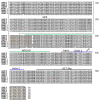Development of Molecular Markers for Predicting Radish (Raphanus sativus) Flesh Color Based on Polymorphisms in the RsTT8 Gene
- PMID: 34371589
- PMCID: PMC8309288
- DOI: 10.3390/plants10071386
Development of Molecular Markers for Predicting Radish (Raphanus sativus) Flesh Color Based on Polymorphisms in the RsTT8 Gene
Abstract
Red radish (Raphanus sativus L.) cultivars are a rich source of health-promoting anthocyanins and are considered a potential source of natural colorants used in the cosmetic industry. However, the development of red radish cultivars via conventional breeding is very difficult, given the unusual inheritance of the anthocyanin accumulation trait in radishes. Therefore, molecular markers linked with radish color are needed to facilitate radish breeding. Here, we characterized the RsTT8 gene isolated from four radish genotypes with different skin and flesh colors. Sequence analysis of RsTT8 revealed a large number of polymorphisms, including insertion/deletions (InDels), single nucleotide polymorphisms (SNPs), and simple sequence repeats (SSRs), between the red-fleshed and white-fleshed radish cultivars. To develop molecular markers on the basis of these polymorphisms for discriminating between radish genotypes with different colored flesh tissues, we designed four primer sets specific to the RsTT8 promoter, InDel, SSR, and WD40/acidic domain (WD/AD), and tested these primers on a diverse collection of radish lines. Except for the SSR-specific primer set, all primer sets successfully discriminated between red-fleshed and white-fleshed radish lines. Thus, we developed three molecular markers that can be efficiently used for breeding red-fleshed radish cultivars.
Keywords: InDels; RsTT8; SNPs; flesh color; molecular marker.
Conflict of interest statement
The authors declare no conflict of interest.
Figures









References
-
- Chen F., Xing C., Huo S., Cao C., Yao Q., Fang P. Red pigment content and expression of genes related to anthocyanin biosynthesis in radishes (Raphanus sativus L.) with different colored flesh. J. Agric. Sci. 2016;8:10.5539. doi: 10.5539/jas.v8n8p126. - DOI
-
- Muminović J., Merz A., Melchinger A.E., Lubberstedt T. Genetic structure and diversity among radish varieties as inferred from AFLP and ISSR analyses. J. Am. Soc. Hortic. Sci. 2005;130:79–87. doi: 10.21273/JASHS.130.1.79. - DOI
Grants and funding
LinkOut - more resources
Full Text Sources

